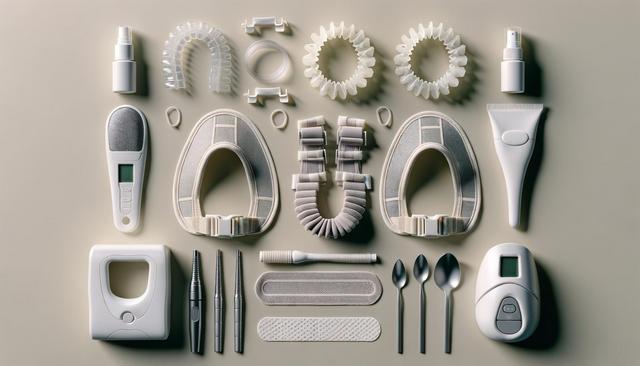What Causes Snoring and Why It Matters
Snoring occurs when airflow is partially obstructed during sleep, causing vibrations in the tissues of the throat and nose. This obstruction can be due to various factors such as nasal congestion, sleep position, alcohol consumption, or anatomical issues like a deviated septum or enlarged tonsils. While occasional snoring may not be serious, chronic snoring can be a sign of underlying health problems, including sleep apnea, which may require medical attention.
It’s important to address snoring not only for better sleep quality but also for overall health. Poor sleep can lead to fatigue, irritability, and decreased concentration. In more severe cases, it may even increase the risk of cardiovascular conditions and metabolic issues. Anti-snoring devices are designed to reduce or eliminate snoring by improving airflow during sleep, making them a valuable option for many individuals.
Types of Anti-Snoring Devices
There are several types of anti-snoring devices available on the market, each designed to target different causes of snoring. Some of the most commonly used categories include:
- Mandibular Advancement Devices (MADs): These mouthpieces reposition the lower jaw slightly forward to keep the airway open.
- Tongue Stabilizing Devices (TSDs): These hold the tongue in place to prevent it from blocking the throat during sleep.
- Nasal Dilators: These are inserted into the nostrils to keep nasal passages open and improve airflow.
- Chin Straps: These help keep the mouth closed during sleep, which encourages nasal breathing.
- Smart Anti-Snoring Devices: These may include wearable tech that detects snoring sounds and responds with gentle vibrations or positional changes.
Choosing the right device depends on the cause of snoring and personal comfort preferences. Consulting a healthcare provider can be beneficial in selecting an appropriate solution.
How Anti-Snoring Devices Work
Anti-snoring devices function by addressing the physical causes of snoring. For instance, mandibular advancement devices work by moving the lower jaw forward, which increases the size of the upper airway and reduces air resistance. This helps minimize tissue vibration and snoring sounds. Tongue stabilizing devices, on the other hand, focus on preventing the tongue from falling back into the throat, a common issue during deep sleep.
Nasal dilators are effective for those whose snoring originates from nasal blockages. By widening the nasal passages, these devices reduce the effort needed to breathe through the nose. Other devices, like positional therapy tools, help users avoid sleeping on their backs, a position that often exacerbates snoring. Some advanced devices even use sensors to detect snoring and provide real-time adjustments to help open the airway.
The effectiveness of these devices can vary from person to person. Factors such as the severity of snoring, the presence of sleep apnea, and individual anatomy can influence results. However, many users report a noticeable decrease in snoring frequency and intensity after consistent use.
Benefits and Considerations of Using Anti-Snoring Devices
Anti-snoring devices offer several potential benefits, especially for those seeking non-invasive solutions to sleep disruptions. Some advantages include:
- Improved sleep quality for both the user and their partner
- Increased daytime alertness and better mood
- Portable and travel-friendly options available
- Non-surgical and drug-free approach
However, there are also important considerations to keep in mind. Some users may experience initial discomfort or require an adjustment period when using oral devices. Fit and sizing are critical for effectiveness and comfort. Additionally, individuals with dental issues, such as loose teeth or jaw pain, should consult a dentist before using a mandibular advancement device.
It’s also important to recognize that while anti-snoring devices can be effective for snoring, they are not always suitable for treating sleep apnea. In such cases, a comprehensive medical evaluation is necessary. Following the manufacturer’s instructions and maintaining device hygiene will also ensure better outcomes and durability.
Choosing and Maintaining Your Device
Selecting an anti-snoring device involves evaluating your specific needs and preferences. Some key factors to consider include:
- Cause of Snoring: Identifying whether your snoring is due to nasal blockage, tongue position, or jaw alignment can help guide your choice.
- Material and Comfort: Materials should be safe, hypoallergenic, and comfortable for extended use.
- Ease of Cleaning: Look for devices that are easy to clean and maintain to ensure hygiene.
- Adjustability: Some mouthpieces offer adjustable settings to customize the fit.
Once you have chosen a device, proper maintenance is essential. Clean the device regularly using the recommended method—typically warm water and mild soap. For mouthpieces, a toothbrush can help remove debris. Store the device in a dry, clean case when not in use to prolong its lifespan.
Periodic replacement may be necessary, especially for devices made of soft materials that wear down over time. Monitoring comfort and effectiveness over time can help determine when a replacement is due. Additionally, if the device causes pain or irritation, discontinue use and consult a healthcare provider for alternatives.


